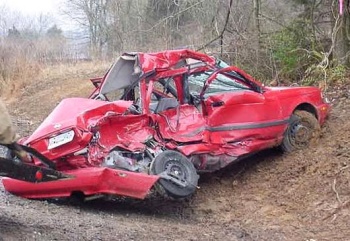 Index
Index

The top four causes of death in the United States are heart disease, cancer, stroke and chronic lower respiratory diseases. Accidents and unintentional injuries are the fifth most common cause of death, and the number of accidental deaths exceed those caused by diabetes, Alzheimer's disease, influenza, kidney disease or bacterial infections.[1] The most frequent types of accidental deaths are motor vehicle traffic accidents, unintentional poisonings, and unintentional falls. This page discusses what you can do to reduce these risks.
|
Total Unintentional Deaths |
Motor Vehicles |
Poisoning | Falls | |
|---|---|---|---|---|
|
Number of deaths |
123,706 | 42,031 | 29,846 | 22,631 |
|
Deaths per 100,000 population |
41.0 | 13.9 | 9.9 | 7.5 |
Statistics from the CDC show that three quarters of all accidental deaths are due to traffic accidents, poisonings, and falls. Many accidental deaths can be avoided by adopting common sense safety measures, but not all accidents can be avoided. The newspapers frequently write about cases where a tree falls on a vehicle or a home during a storm and kills one or more occupants, while other cases involve near misses where a person avoids death by a few inches or seconds. A non-fatal accident can change the rest of your life forever, and a fatal accident has financial and psychological consequences for your family and friends. The best strategy for avoiding accidents is to be aware of your surroundings, and take preventive measures where possible.
Most cases of poisoning and fatal falls occur in the home. Poisonings are usually caused by overdoses of prescription medicines which are taken either through forgetfulness or in an attempt to get faster and more thorough relief. Death from traffic accidents and falls usually results from impacts to the head or massive bleeding from cuts or internal injuries. Accidents that cause breakage of bones may not cause death immediately, but they reduce the quality of life and make death more imminent.

Avoid Traffic Accidents
Automobile accidents are responsible for
a large number of deaths, some of which could be prevented by using a seat belt, avoiding
distractions such as mobile telephones, obeying traffic signals, and never drinking and driving.
Many of these safety measures are already laws which are enforced by fines and
suspension of driving privileges, but it is up to you to assure your own safety and that
of your passengers. You may not be the one who dies in a traffic accident, it may be
someone riding in your car, and you are responsible for making sure that your passengers
use their seat belts and don't distract you while you are driving.
Here are some tips to make your trip safer:
When driving, you always have to watch out for other vehicles. Many accidents occur as a result of road rage, driving while intoxicated, or unusual maneuvers by new drivers who lack experience. You will be safer by staying out of the way of irresponsible drivers.

Avoid Poisoning
In 2008, more than 36,000 people died from drug overdoses, and most of these deaths
were caused by prescription drugs.[3]
Every day, nearly 82 people die as a result of unintentional poisoning and another 1,941 are treated
in emergency departments. As shown in the chart, unintentional poisoning deaths in the
United States increased by 145% from 1999 to 2007.
Drug overdose death rates in the US are at an all-time high, and have more than tripled since 1990.
Prescription painkillers have now surpassed heroin and cocaine as the leading
cause of fatal overdoses.
The drugs causing the most deaths are prescription opioid painkillers such as oxycodone, hydrocodone, fentanyl, morphine and methadone. Fortunately, there are oxycodone, hydrocodone, morphine, methadone and fentanyl addiction treatment centers that can help prevent fatalities from abuse of these painkillers.
Many deaths are also caused by antipsychotic medications such as clozapine and risperidone (Risperdal), as well as overdoses of non-prescription painkillers, such as acetaminophen (Tylenol). Acetaminophen can cause irreversible and sometimes fatal liver damage in doses that are not much higher than the recommended dose for headaches and muscle pain.
Overdose of painkillers generally occurs when a patient is unable to get sufficient pain relief with the prescribed dosages of the drug. Taking excess medication may not provide additional relief, but it increases the chances of overdose and death. Some pain medications, like methadone, can be fatal when combined with certain antidepressants, sedatives or cardiac medicines. Another problem with opioid painkillers is that they are generally addictive or produce euphoria. Many deaths are due to abuse of these substances as a result of addiction. Thankfully, there are private centers for those who became addicted to methadone or any other painkiller. Some patients use multiple doctors to obtain prescriptions for painkillers and narcotics including OxyContin and Percocet, which can be abused easily and resold illegally. The misuse of prescription drugs results in about 475,000 emergency room visits annually, according to the United States Department of Health and Human Services.
You can avoid poisonings by keeping track of your medications and by verifying with your doctor and pharmacist about possible toxic drug interactions between combinations of prescription or over-the-counter drugs. Many people who take multiple medications organize them in pill boxes that hold the medicines for each day of the week. This makes it possible to take the required medicine on the appropriate schedule and reduce the chance of overdosing.



Avoid Falls
Falls that cause severe injuries, such as hip fractures and head traumas,
can increase the risk of early death.
Falls are the most common cause of traumatic brain injuries.
In 2000, brain injuries accounted for 46% of fatal falls among older adults.
Many of the fractures suffered during falls are caused by weak bones. According to the American Academy of Orthopaedic Surgeons, one of every two women and one of every four men over age 50 will suffer a fracture related to osteoporosis.[5] Falls are the leading cause of injuries for adults 65 and older. The life expectancy of a person who has broken a hip usually decreases by five or six years.[4] The reason for this is that the person becomes completely dependent on others and needs assistance with basic functions such as food preparation, use of the bathroom and personal hygiene.
In the home, the most common mortal injuries are caused by falling down stairs, tripping on rugs, or slipping in the shower and injuring the head. These accidents can be prevented by using handrails, by keeping floors clear of obstructions and by using non-slip mats in the shower. In the winter, most falls are caused by slipping on snow, ice, or wet leaves. Falling off ladders is also common in the autumn and winter when people try to clean leaves from the roof gutters or hang Christmas decorations.
The rules for safety are based on common sense. Avoid tasks or activities that increase your chances of getting hurt. Learn from the mistakes of others and don't repeat their mistakes.
Make your home fall-proof
Follow these simple suggestions to make your home safer:





Sharp knives and hot stoves pose the risk of cuts, burns and fires. Handle knives and hot items carefully. Have a first aid kit handy. Do not leave stoves unattended while in use.
References: